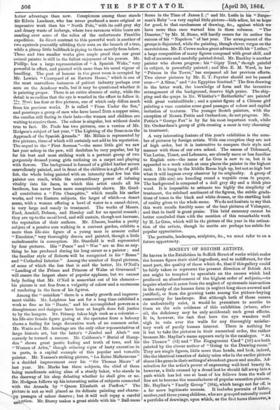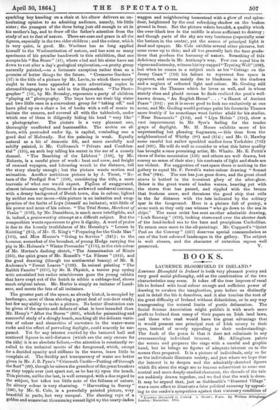SOCIETY OF BRITISH ARTISTS.
So barren is the Exhibition in Suffolk Street of works which make the human figure their chief ingredient, and so indifferent, for the most part, the quality of those which do, that if this gallery could be fairly taken to represent the present direction of British Art tine might be tempted to speculate on the causes which had produced an abandonment of the highest order of subjects,—to inquire whether it arose from the neglect of systematic instruction in the study of the human form (a neglect long since avowed and justified), or from the growing taste among the picture-buying community for landscape. But although both of these causes do undoubtedly exist, it would be premature to ascribe to them on the sole evidence of this exhibition (where, after all, the deficiency may be only accidental) such great effects. It is, however, the fact that here the eye wanders well nigh in vain over the walls for any thoroughly satisfac- tory work of purely human interest. There is nothing for it but to take the pictures in their numerical order, the rather because Mr. Hayllar's name appears early in the catalogue. "At the Theatre" (12) and " The Engagement Card" (16) are both painted by the clever author of "Going to the Drawing-room." They are single figures, little more than heads, and look, indeed, like the identical beauties of dainty mien who in the earlier picture shone like gems in their settingof abundant gauze and musliu. Ad- miration for the artist's power of expressing well-bred beauty is, however, a little crossed by a dread lest he should fall away into a path which has led one at least of his fellows from the walk of fine art to become the manufacturer of popular sensation pictures. Mr. Hayllar's "Family Group" (294), which hangs not far off, is a far more legitimate success. It includes portraits of father, mother,and three young children, who are grouped naturally round a portfolio of drawings, upon which, as the first turns themover, a
sparkling boy kneeling on a chair at his elbow delivers an un- hesitating opinion to an admiring audience, namely, his little sister; the youngest of the three being just old enough to sit in his mother's lap, and to draw off the father's attention from the study of art to that of nature. There are ease and grace in all the figures, especially in the two elder children ; and the colour, which is very quiet, is good. Mr. Woolmer has so long applied himself to the Woolmerization of nature, and has sent so many specimens of his peculiar handiwork to this exhibition, that one accepts his "Sea Shore" (47), where a lad and his sister have sat down to rest after a day's geological exploration,—a pretty group naturally painted,—as a fortunate exception rather than as a .promise of better things for the future. " Cremorne Gardens" (57) is the title of a picture by Mr. Levin, to which there surely ought to have been appended a note advertising copies in chromolithography to be sold in the Haymarket. "The Photo- grapher" (72), by Mr. Bromley, represents a party of children "playing at" photography. The boys have set their big sister and two little ones in a convenient group for "taking off," and have piled up on a chair a lot of books with a roll of music to imitate the camera, and covered all with the tablecloth, under which one of them is diligently biding his head "very like"
a photographer. The picture is a very pleasant one, thoroughly unaffected and businesslike. The urchin on all fours,. with protruded under lip, is capital, reminding one a good deal of Mulready. But the painting is weak. Equally natural as a bit of domestic life, and more carefully and solidly painted, is Mr. Collinson'a " Private and Confiden- tial" (135), an arch boy telling his secret in the ear of a comely damsel. "The Beaching of the Lifeboat" (158), by Mr. Roberts, is a careful piece of work : boat and crew, and freight of rescued voyagers, and labouring wreck in the distance, tell the story clearly enough ; but the picture wants motion and animation. Another ambitious picture is by J. Tissot, " Re- turn of the Prodigal San" (259), considering the title, a mere travestie of what one would expect. Figares of exaggerated, almost inhuman ugliness, dressed in awkward medieval costume, -with a dreary background of Dutch town, dim in colour, lighted by neither sun nor moon—this picture is an imitation and exag- geration of the faults of Lays (himself an imitator), with little of his power and none of his colour. "The Trial scene, Merchant of Venice" (678), by Mr. Donaldson, is much more intelligible, and is, indeed, a praiseworthy attempt at a difficult subject. But the composition wants squareness to give it dignity. A word of praise is due to the homely truthfulness of Mr. Hemsley's "Lesson in Knitting" (85), of Mr. H. King's "Preparing for the Gude Man"
(105), and, Miss Hunter's "Going to Service" (241); to the humour, somewhat of the broadest, of young Hodge carrying the pig in Mr. Holmes's "Winter Provender" (175), to the rich colour of Mr. Morten's dashing sketch, "The Assassination of Rizzio (255), the quiet grace of Mr. Russell's "La Fileuse " (512), and the good drawing (though too sentimental beauty) of Mr. S. Anderson's "Forest Leaves " (729). In animal painting "The Rabbit Fancier" (617), by Mr. R. Physick, a terrier pup eyeing with astonished but rather mischievous gaze the young rabbits that have crept out of the hutch to nibble a cabbage-leaf, shows much original talent. Mr. Honor is simply an imitator of Land- seer, and meets the fate of all imitators.
The greater part of the space, as already hintsd, is occupied by landscapes, most of them showing a great deal of out-door study, but few any ability to make a picture. No better illustration can be given of the merits and defects of what is here intended than Mr. Hemy's "After the Storm" (663), which for painstaking and successful study of a shingly beach, marking all the delicate vane- flea of colour and sinuo-sities of curvature in the water-worn rocks and the effect of pervading daylight, could scarcely be sur- passed. Yet for any interest excited by the battered hull and scattered figures in mid-distance (which are the only excuse for the title) it is an absolute failure,—the attention is constantly re- called to the technical merits of the foreground, which, except for a decided opacity and stiffness in the waves, leave little to complain of. The fluidity and transparency of water are better given in Mr. J. B. Pyne's " Cricceath Castle—Putting off through the Surf" (99), though he misses the grandeur of the great breakers as they topple over (not spurt out, as he has it) upon the beach. This picture, unlike the last, is well arranged, with a due regard to the subject, but takes too little note of the fullness of nature. Its silvery colour is very charming. "Harvesting in Surrey"
(106), by Mr. G. Cole, is a powerfully painted picture, very beautiful in parts, but very unequal. The slanting rays of a golden and somewhat threatening sunset light up the heavy-laden
waggon and neighbouring homestead with a glow pf real splen- dour, heightened by the cool refreshing shadow on the broken ground in front. But the picture wants breadth, a quality which the over-black tree in the middle is alone sufficient to destroy ; and though parts of the sky are very luminous (especially near the horizon in the centre), yet the source of principal light is dead and opaque. Mr. Cole exhibits several other pictures, but none come up to this; and all to generally lack the finer grada- tions that produce the harmony of nature. Something of this deficiency stands in Mr. Anthony's way. Few can equal him in vigour and intensity, witness his ivy-capped " Trysting Well" (400, but when he comes to a subject such as his "Cottage on the Jersey Coast" (716) his failure to represent free space is apparent, and seems mainly due to blackness in the shadows and a neglect of reflected light and colour. Mr. Gosling still lingers on the Thames which he loves so well, and in whose stately elms and placid stream he finds realized the poet's well- known dream, "An English Home". . . "a Haunt of Ancient Peace" (182) : yet it is never good to look too exclusively at one scene, and Mr. Gosling would perhaps paint his favourite Thames more freshly if he sometimes went further afield for his studies. " Near Beaumaris" (134), and " Llyn Helsie" (324), show a vast improvement in Mr. Syer's feeling for the tender grays of daylight. Mr. H. Moore exhibits more of his unpretending but pleasing fragments, — this time from the neighbourhood of Whitby (98) and (374) ; and Mr. G. Mawley some careful but rather speckled studies from Yorkshire (752) and (937). He will do well to consider to what this latter quality has brought a once promising artist, Afr. Whaite. Mr. E. Pettit's views of Swiss mountains (150) and others are well drawn, but convey no sense of their size ; his contrasts of light and shade are too violent. For suggestion of vast space there is nothing in the gallery to equal Mr. F. Powell's water-colour drawing " Sunset at Sea" (994.). The sun has just gone down, and the great cloud above is bathed in the transient glory of the after-glow. Below is the great waste of leaden waters, heaving yet with the storm that has passed, and rippled with the breeze that freshens anew, and threatens the good ship that rolls in the far distance with the fate indicated by the solitary spar in the foreground. Here is a picture full of poetry, a scene such as they only can witness "who go down to the sea in ships." The same artist has sent another admirable drawing, "Loch Scavaig " (979), looking shoreward over the shorter dash of the land-locked sea to the bare and precipitous Cuchullins. To return once more to the oil-paintings-. Mr. Coppard's "Quiet Pool on the Conway" (257) deserves special commendation as one of the best coloured landscapes in the gallery. The subject is well chosen, and the character of unbroken repose well



































 Previous page
Previous page